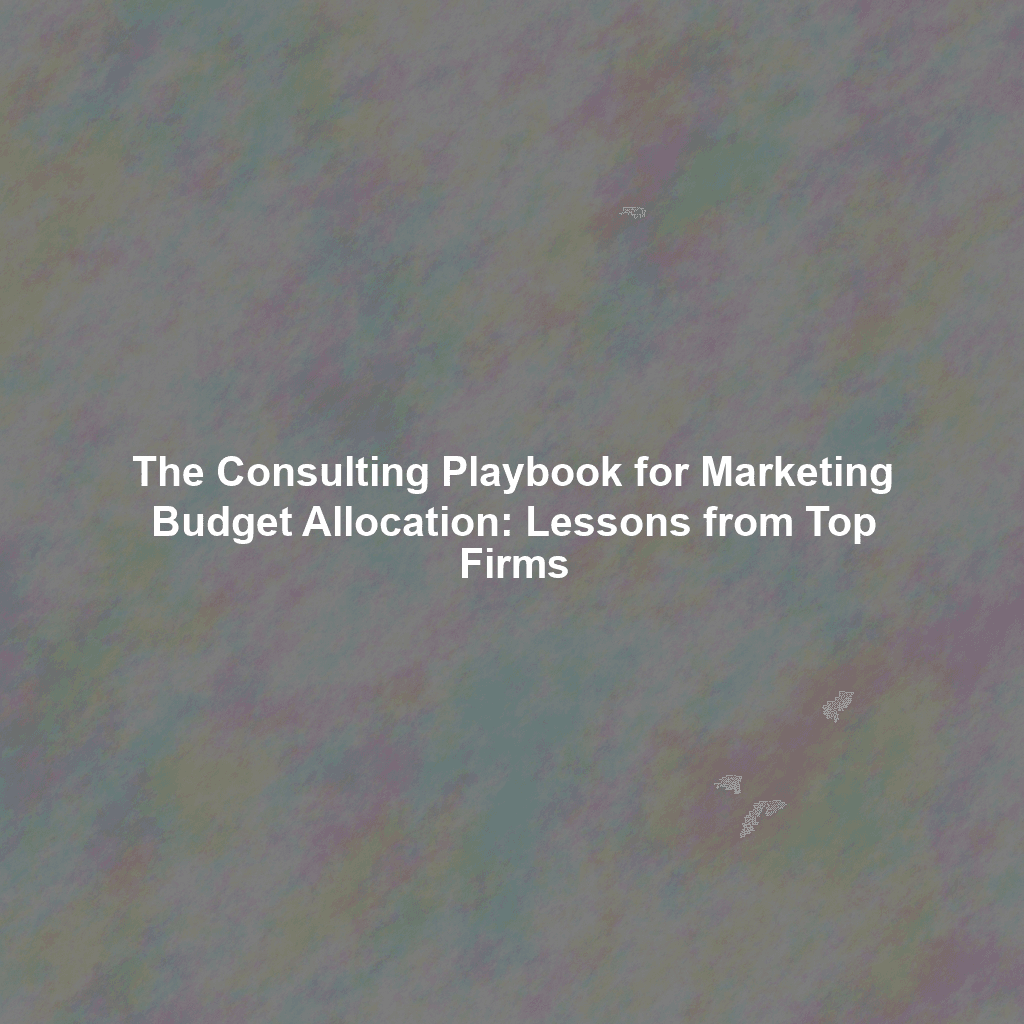Every marketing department faces the same daunting challenge: how to allocate its budget effectively to maximize ROI. In an era of fragmented media landscapes and increasingly sophisticated consumers, making the right investment decisions is more critical than ever. Luckily, we can learn from the best. This article delves into the strategies employed by top management consulting firms like McKinsey, BCG, Bain, and Oliver Wyman to advise their clients on optimal marketing budget allocation. We’ll explore their proven methodologies and offer actionable advice you can use to optimize your own marketing spend.
The Core Principles Guiding Top Consulting Firms
Before diving into specific tactics, it’s crucial to understand the fundamental principles that underpin how top consulting firms approach marketing budget allocation. These principles serve as the foundation for a data-driven and strategic approach.
Data-Driven Decision Making: The Anti-Gut Feeling Approach
Forget hunches. McKinsey, BCG, and their peers champion data-driven decision-making. This means meticulously tracking marketing performance across all channels, analyzing key metrics like customer acquisition cost (CAC), customer lifetime value (CLTV), and return on ad spend (ROAS). Consultants leverage advanced analytics and modeling to understand which marketing activities are truly driving results and which are simply draining resources.
Customer-Centricity: Know Your Audience Inside and Out
Understanding your target audience is paramount. Top consulting firms emphasize detailed customer segmentation, persona development, and journey mapping. By deeply understanding customer needs, behaviors, and preferences, companies can tailor their marketing messages and channel choices to resonate most effectively, leading to higher conversion rates and better ROI. Bain & Company often leverages its proprietary Net Promoter Score (NPS) methodology to gauge customer loyalty and identify areas for improvement in the customer experience, which directly impacts marketing effectiveness.
Agile Budgeting: Adaptability in a Dynamic Landscape
The marketing landscape is constantly evolving. What worked yesterday might not work tomorrow. Therefore, leading consulting firms advocate for agile budgeting processes. This involves regularly reviewing and adjusting marketing budgets based on performance data, emerging trends, and competitive activity. This adaptability ensures that marketing resources are always allocated to the most promising opportunities.
A/B Testing and Continuous Optimization: Small Changes, Big Impact
McKinsey, in particular, is a strong proponent of A/B testing. They believe that even small tweaks to marketing campaigns can have a significant impact on performance. By constantly testing different messaging, creative elements, and targeting parameters, companies can identify what resonates best with their audience and continuously optimize their campaigns for maximum effectiveness. This iterative approach leads to ongoing improvements in marketing ROI.
Practical Strategies from the Consulting Playbook
Now, let’s translate these principles into actionable strategies you can implement in your own organization.
Conduct a Thorough Marketing Audit
Before making any changes to your budget allocation, conduct a comprehensive audit of your current marketing activities. This involves:
- Analyzing past performance: Identify which channels and campaigns have delivered the best ROI.
- Evaluating your marketing technology stack: Ensure you have the right tools in place to track and analyze marketing performance.
- Assessing your competitive landscape: Understand how your competitors are allocating their marketing budgets and what strategies they are employing.
Implement Robust Tracking and Analytics
You can’t improve what you don’t measure. Invest in robust tracking and analytics capabilities to monitor the performance of your marketing activities in real-time. This includes:
- Setting up clear KPIs: Define the key performance indicators (KPIs) that matter most to your business, such as website traffic, lead generation, and sales conversions.
- Using marketing automation tools: Automate marketing tasks and track customer interactions across different channels.
- Leveraging data visualization tools: Create dashboards and reports to visualize marketing performance data and identify trends.
Prioritize High-ROI Channels
Based on your data analysis, identify the channels and campaigns that are delivering the best ROI. Allocate a larger portion of your budget to these high-performing areas. This may involve shifting resources from less effective channels to more promising ones.
Embrace Experimentation and Innovation
Don’t be afraid to experiment with new marketing channels and technologies. Allocate a small portion of your budget to test new ideas and see what works. This could involve trying out new social media platforms, investing in influencer marketing, or exploring emerging technologies like artificial intelligence (AI).
Regularly Review and Adjust Your Budget
As mentioned earlier, agile budgeting is essential. Regularly review your marketing budget based on performance data and market trends. Be prepared to make adjustments as needed to optimize your spending and maximize your ROI.
Examples in Practice: Hypothetical Scenarios
Let’s consider a couple of scenarios to illustrate how these principles can be applied in practice.
- Scenario 1: E-commerce Retailer Struggling with CAC. A consulting firm like Oliver Wyman might advise them to conduct detailed attribution modeling to pinpoint the customer touchpoints contributing most to conversions. This might reveal that paid social media is driving awareness, but email marketing is closing the deals. The recommendation would be to reallocate budget to nurture email sequences and optimize the website for a smoother purchase experience, thus reducing CAC.
- Scenario 2: B2B Software Company Launching a New Product. BCG could recommend a phased approach, starting with targeted account-based marketing (ABM) campaigns to key decision-makers. They’d emphasize content marketing – white papers, webinars, and case studies – demonstrating the value proposition. As the product gains traction, the budget could shift towards broader awareness campaigns.
Conclusion: Mastering the Art of Marketing Budget Allocation
Effective marketing budget allocation is not a one-size-fits-all solution. It requires a data-driven, customer-centric, and agile approach. By adopting the principles and strategies used by top management consulting firms like McKinsey, BCG, Bain, and Oliver Wyman, you can optimize your marketing spend, drive better results, and achieve your business goals. The key is to constantly learn, adapt, and refine your approach based on the evolving marketing landscape and the unique needs of your customers.
 Skip to content
Skip to content

